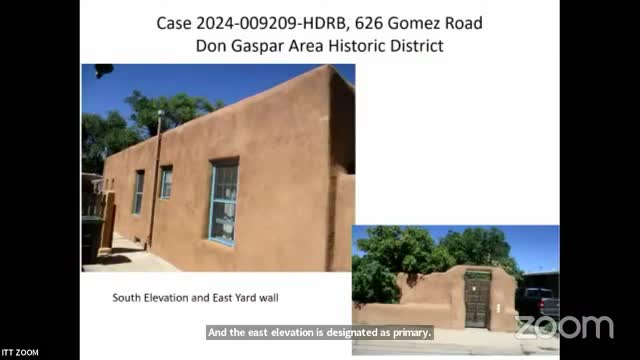Controversial Home Additions Spark Historic Preservation Debate
October 23, 2024 | Santa Fe, Santa Fe County, New Mexico
This article was created by AI summarizing key points discussed. AI makes mistakes, so for full details and context, please refer to the video of the full meeting. Please report any errors so we can fix them. Report an error »

In a recent government meeting, discussions centered around proposed exterior alterations to a historic property, originally constructed between 1935 and 1942, which has undergone various modifications over the decades. The most recent changes, made without a permit in 2023, included the addition of three portals on the west elevation of the house, prompting a stop work order from the city's historic preservation division.
The applicant seeks approval for these alterations, which total 210 square feet—approximately 14% of the existing footprint. The proposed structures feature wood posts and beams, painted blue to match existing windows, and roofs made of corrugated metal. However, the design has drawn criticism for not being harmonious with the original Adobe style of the home, which is characterized by its Spanish Pueblo Revival architecture.
The Technical Advisory Committee (TAF) has recommended denial of the project, citing non-compliance with design standards for historic districts. Members of the board expressed concerns about the modern aesthetic of the additions, particularly the use of corrugated metal and the overall design, which they felt did not integrate well with the historic character of the house.
While some board members acknowledged the functional need for the additions, they emphasized the importance of maintaining architectural harmony within the historic district. Suggestions were made for potential modifications to the existing structures to better align with the original style, including the possibility of stuccoing unfinished areas and simplifying the variety of materials used.
The applicant's architect defended the design, arguing that the additions serve practical purposes and that the previous structures were in disrepair. He expressed willingness to collaborate with the board to find a compromise that respects both the functional needs of the property and the aesthetic standards of the historic district.
The meeting concluded with a call for further deliberation on how to address the design concerns while allowing the applicant to retain the functional improvements made to the property. The board is expected to revisit the case, weighing the need for historical preservation against the practical realities of home improvement.
The applicant seeks approval for these alterations, which total 210 square feet—approximately 14% of the existing footprint. The proposed structures feature wood posts and beams, painted blue to match existing windows, and roofs made of corrugated metal. However, the design has drawn criticism for not being harmonious with the original Adobe style of the home, which is characterized by its Spanish Pueblo Revival architecture.
The Technical Advisory Committee (TAF) has recommended denial of the project, citing non-compliance with design standards for historic districts. Members of the board expressed concerns about the modern aesthetic of the additions, particularly the use of corrugated metal and the overall design, which they felt did not integrate well with the historic character of the house.
While some board members acknowledged the functional need for the additions, they emphasized the importance of maintaining architectural harmony within the historic district. Suggestions were made for potential modifications to the existing structures to better align with the original style, including the possibility of stuccoing unfinished areas and simplifying the variety of materials used.
The applicant's architect defended the design, arguing that the additions serve practical purposes and that the previous structures were in disrepair. He expressed willingness to collaborate with the board to find a compromise that respects both the functional needs of the property and the aesthetic standards of the historic district.
The meeting concluded with a call for further deliberation on how to address the design concerns while allowing the applicant to retain the functional improvements made to the property. The board is expected to revisit the case, weighing the need for historical preservation against the practical realities of home improvement.
View full meeting
This article is based on a recent meeting—watch the full video and explore the complete transcript for deeper insights into the discussion.
View full meeting
